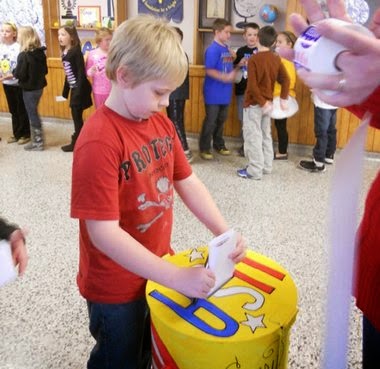
The baby is kind of cute, though.
And the baby is the inspiration for our story today: Pinduli, by Janell Cannon, author of Stellaluna. In the story Pinduli doesn't have a problem with herself until she runs into some other animals who tease her about her appearance.
At the beginning of the story, Pinduli (isn't she adorable?) and Mama Hyena are having a hard time finding food. They are separated in their hunt, and Pinduli comes across different animals. She meets a pack of wild dogs, a lion, and a zebra, and each make fun of her appearance: her ears, her stripes, and her tail. She becomes very self-conscious, so she tucks her ears and tail in and rolls in the dirt until her striped coat is a pallid gray. As she shame-facedly makes her way home to Mama Hyena, she runs into the animals that made fun of her. The animals think that she is a ghost that has come to punish them, so Pinduli toys with them. All of the creatures confess that they teased the young hyena because another animal had made fun of them. Pinduli understands their motives and advises them to "find your tormentors and make peace," She also tells them they should always leave a bit of every meal as an offering to the ghost. By the end of the story, the animals are reconciled and with all the food offerings left for the "ghost," Pinduli and her mother no longer have to scrounge for food.
Aside from the character building that could come from this story, there are many opportunities to teach students how to visualize, or how to see the story in their minds using their own imagination. This is an important reading strategy that greatly improves reading comprehension. Imagine the lovely pictures students could form in their minds with text like this from Pinduli: "The sun was low in the East African sky. The animals had been sleeping all through the hot afternoon, and now they begin to stir." There are many pre-reading and post-reading tasks to practice visualization:



This story may need some background information because of some vocabulary that students may not be familiar with or animals they may never have seen before. In order to visualize to the greatest extent, students should know what words and animals are in the story. Of course, there are many other ideas for teaching and developing visualization skills, but these were some of our favorites. Again, if you enjoy the story of Stellaluna, you will no doubt enjoy what Pinduli has to offer. Just remember: real striped hyenas are not as cute as Pinduli. She is the cutest ugly animal you'll ever see.
Aside from the character building that could come from this story, there are many opportunities to teach students how to visualize, or how to see the story in their minds using their own imagination. This is an important reading strategy that greatly improves reading comprehension. Imagine the lovely pictures students could form in their minds with text like this from Pinduli: "The sun was low in the East African sky. The animals had been sleeping all through the hot afternoon, and now they begin to stir." There are many pre-reading and post-reading tasks to practice visualization:
- Take notes to draw their own pictures of what they think the scenes looked like after the read-aloud (would also teach to pay attention to details in the text). See example worksheet below.
- Have discussions with a partner or as a class of what Pinduli looked like when her feelings and appearances were changed
- Draw a sequence of events through their visualizations. See example below.
- Discuss what the landscape of Africa looks like where Pinduli hunts
- Write a narrative with a picture of something they visualized explaining why they visualized this, what details in the text made them visualize what they did, and what does their visualization tell them about the characters, themes, or main ideas
- Copying a passage of a story onto big paper and explicitly showing children what words trigger visualization is a wonderful idea we found on Pinterest (of course!), example below.
This story may need some background information because of some vocabulary that students may not be familiar with or animals they may never have seen before. In order to visualize to the greatest extent, students should know what words and animals are in the story. Of course, there are many other ideas for teaching and developing visualization skills, but these were some of our favorites. Again, if you enjoy the story of Stellaluna, you will no doubt enjoy what Pinduli has to offer. Just remember: real striped hyenas are not as cute as Pinduli. She is the cutest ugly animal you'll ever see.









